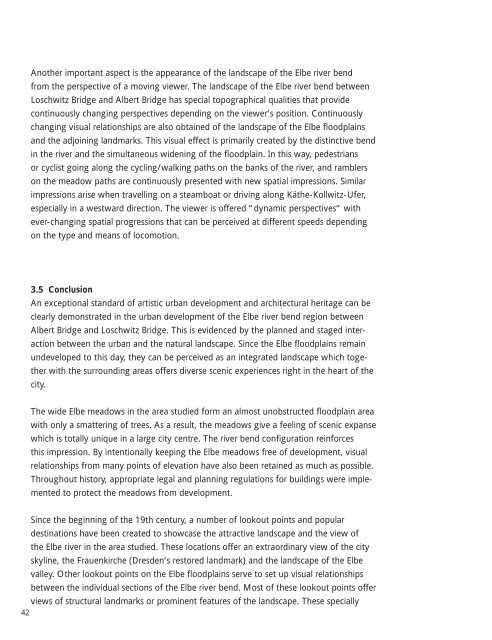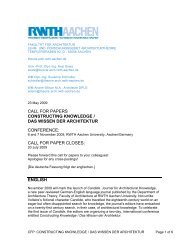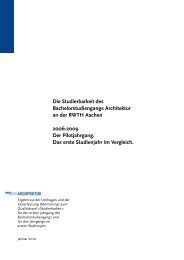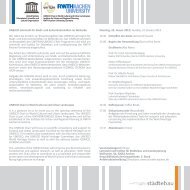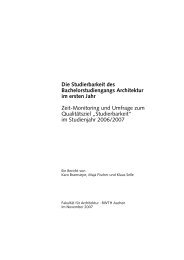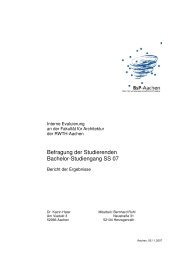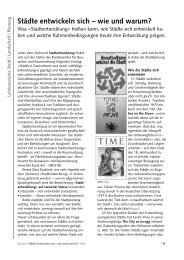Gutachten Dresden_englisch_dritte f.indd - Fakultät für Architektur ...
Gutachten Dresden_englisch_dritte f.indd - Fakultät für Architektur ...
Gutachten Dresden_englisch_dritte f.indd - Fakultät für Architektur ...
Create successful ePaper yourself
Turn your PDF publications into a flip-book with our unique Google optimized e-Paper software.
Another important aspect is the appearance of the landscape of the Elbe river bend<br />
from the perspective of a moving viewer. The landscape of the Elbe river bend between<br />
Loschwitz Bridge and Albert Bridge has special topographical qualities that provide<br />
continuously changing perspectives depending on the viewer‘s position. Continuously<br />
changing visual relationships are also obtained of the landscape of the Elbe floodplains<br />
and the adjoining landmarks. This visual effect is primarily created by the distinctive bend<br />
in the river and the simultaneous widening of the floodplain. In this way, pedestrians<br />
or cyclist going along the cycling/walking paths on the banks of the river, and ramblers<br />
on the meadow paths are continuously presented with new spatial impressions. Similar<br />
impressions arise when travelling on a steamboat or driving along Käthe-Kollwitz-Ufer,<br />
especially in a westward direction. The viewer is offered “dynamic perspectives“ with<br />
ever-changing spatial progressions that can be perceived at different speeds depending<br />
on the type and means of locomotion.<br />
3.5 Conclusion<br />
An exceptional standard of artistic urban development and architectural heritage can be<br />
clearly demonstrated in the urban development of the Elbe river bend region between<br />
Albert Bridge and Loschwitz Bridge. This is evidenced by the planned and staged inter-<br />
action between the urban and the natural landscape. Since the Elbe floodplains remain<br />
undeveloped to this day, they can be perceived as an integrated landscape which toge-<br />
ther with the surrounding areas offers diverse scenic experiences right in the heart of the<br />
city.<br />
The wide Elbe meadows in the area studied form an almost unobstructed floodplain area<br />
with only a smattering of trees. As a result, the meadows give a feeling of scenic expanse<br />
which is totally unique in a large city centre. The river bend configuration reinforces<br />
this impression. By intentionally keeping the Elbe meadows free of development, visual<br />
relationships from many points of elevation have also been retained as much as possible.<br />
Throughout history, appropriate legal and planning regulations for buildings were imple-<br />
mented to protect the meadows from development.<br />
Since the beginning of the 19th century, a number of lookout points and popular<br />
destinations have been created to showcase the attractive landscape and the view of<br />
the Elbe river in the area studied. These locations offer an extraordinary view of the city<br />
skyline, the Frauenkirche (<strong>Dresden</strong>‘s restored landmark) and the landscape of the Elbe<br />
valley. Other lookout points on the Elbe floodplains serve to set up visual relationships<br />
between the individual sections of the Elbe river bend. Most of these lookout points offer<br />
views of structural landmarks or prominent features of the landscape. These specially<br />
42


